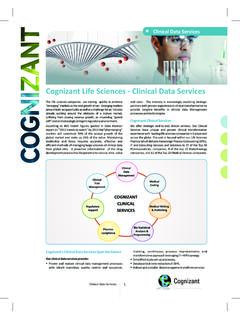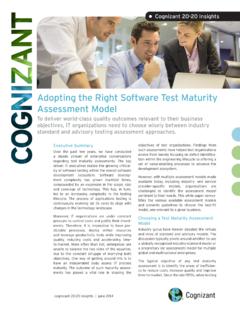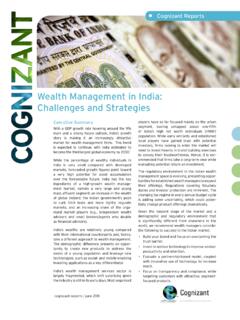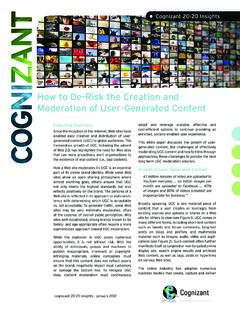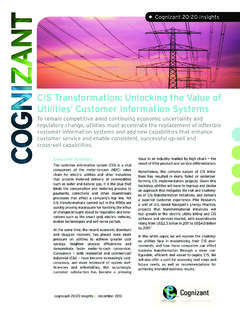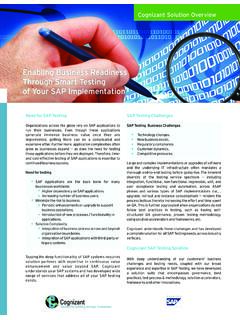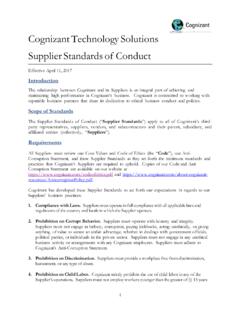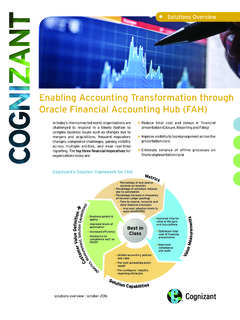Transcription of Making the Right Logistical Move - Cognizant
1 Making the Right Logistical MoveWhether conducted in one fell swoop or in stages, switching logistics services providers requires careful IT planning and execution driven by near- and long-term business objectives, change management, and budget and time Summary Businesses traditionally establish and maintain long-term relationships with multiple third-party logistics (3PL) service providers but are increasingly looking to consolidate around fewer strategic partners. A recent report from Gartner states, the 3PL portfolio rationalization trend is continuing, as the number of logistics customers who report that they are reducing or consoli-dating the number of 3 PLs they use is over half at 53%.
2 13 PLs have continued to deliver high value for customers by providing innovative solutions to support contemporary business requirements. Their capabilities complement each other as a competitive differentiator. The most commonly used outsourced services are transportation, warehousing, customs brokerage and freight forwarding as well as value-added services like returns, assembly, packaging, shipment consoli-dation and cross-docking. The IT capabilities provided by logistics service providers (LSPs) such as shipment planning, inventory management, supply chain visibility, order management, bar coding, go-to-mar-ket and analytics play a big role in cementing shipper/3PL relationships.
3 However, there is a dis-cernible change in expectations from 3PL service providers as shippers increasingly look forward to a limited set of 3 PLs that can offer integrated services , end-to-end solutions and a seamless experience across functions and white paper looks at the factors that are driving shippers to look beyond their incumbent LSPs, and also examines the various transition options shippers can employ, in terms of business suitability, implementation feasibility and benefit 20-20 insights | april 2016 Cognizant 20-20 Insightscognizant 20-20 insights2 The Changing Face of LogisticsFigure 1 shows a representative logistics setup for a global business.
4 As noted, shippers often tend to partner with multiple service providers and use both insourcing/outsourcing models to address the various logistics needs of shippers and end customers. These practices are more commonly found when shippers operate in different geog-raphies employing different modes of trans-portation. This might seem fruitful in the short term, but has significant repercussions over the long haul, the most detrimental being the lack of consistency across service providers and the limited scalability of operations. These factors are driving a rethink in terms of logistics strategy used by shippers, with many players pushing to consolidate services by moving to one or a few end-to-end 3PL strategic partner(s).
5 Also, new developments in the logistics and distri-bution industry such as the need for cloud-based solutions, omnichannel retailing and analytics are forcing shippers to seek service providers with more advanced technological capabilities. And in our experience, as shippers look to different LSPs for better services or improved integration, end customers also realize great value as their experience improves dramatically. A seamless, Figure 1 COTS Solution for Transportation3rd Party ERP Solution for WMSS hipping InventoryCountingLaborManagementDocument CreationFreight Invoicing & ClaimsOutboundDeliveryLoading Track & TracePutawayPick & PackTransport ProcurementInbound Transportation Outbound Transportation AppointmentSchedulingShipmentOptimizatio nWarehousing Operations Yard Management:In-House Excel-Based SolutionRouteOptimizationUnloadingGoodsR eceipt The Logistics Ecosystem.
6 An Illustrative Viewcognizant 20-20 insights3consistent experience across services and geog-raphies helps shippers secure customer trust and lays the foundation for stronger business , Making a transition to a new LSP without disrupting operations is a daunting task. Most supply chain managers would agree with that view. But when the incumbent LSP constantly fails to meet SLAs, or is incapable of supporting accelerated growth in business operations either through its own processes or the underlying IT systems, organizations are hardly left with a choice. Service levels can be affected by process, people or IT solution issues, thus it is essential to clearly identify the problem to put in place a framework for deciding what and how to change.
7 Many 3PL vendors employ logistics solution suites that integrate with existing IT systems. However, implementation challenges can arise both in terms of feasibility and timelines. The challenge is exac-erbated when the existing solution landscape is a mix of various in-house (home-grown enterprise systems) and LSP-owned systems, each addressing different subprocesses in the logistics value chain. In such cases, a deep dive is required to understand current maturity, migration feasibility, change impact and benefit realization at each logistics subprocess/system combination scalability poses another significant risk that requires careful planning and execution.
8 If the logistics operations of an organization are spread across different geographies and comprise multiple transportation modes (road, air, rail and sea), it is essential to create a solution that is scalable and risk-free. The recommended approach that meets industry best practices is to have a centralized system that promotes process standardization in global operations, with flexibil-ity for customizations to address regional/coun-try-specific , as customer demand increases, a never-ending list of variables emerges. For example, there are multiple systems of engagement (large-scale ERP systems such as SAP and/or Oracle Business Suite coupled with stand-alone systems for bar coding, etc.)
9 , choices of hosting options (on premises or cloud) and multiple platforms to support ( , the wide variety of mobile devices). It has become risky to hold onto legacy systems and archaic practices. Never before has this change been as relevant as it is today where technologies change rapidly and drive businesses in new and more disruptive ways. It is therefore paramount for shippers to choose LSPs that have more agile, reliable and extensible systems. Given this, it is not surprising to see many organizations transitioning from existing LSP partners and onboarding vendors that promise more robust infrastructure, modern IT systems and scalable operations.
10 What follows is our view of the various approaches to LSP transition from a technological perspec-tive, including the relative merits/demerits and relevance of each option in different business scenarios. We have also established evaluation parameters to weigh the different alternatives to help companies choose a strategy that best suits their specific logistics objectives and overall business OptionsTransforming business process and technology comes with a myriad of challenges, the most perplexing of which is managing the transition from old to new IT systems. The first step is to assess the maturity level of various processes (warehousing, picking and packing, transporta-tion, planning, etc.)
